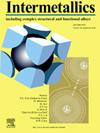Revealing the disparate defect evolution paths with loading rates for ductile and brittle metallic glasses via nanoscale creep
IF 4.3
2区 材料科学
Q2 CHEMISTRY, PHYSICAL
引用次数: 0
Abstract
Ductile and brittle metallic glasses display significantly different mechanical behaviors. However, the microscopic deformation mechanisms and the defect dynamics in different metallic glasses remain unclear. In this work, an experimental strategy based on nanoscale creep was used to detect the defect evolution dynamics at different loading rates for six metallic glasses with varying plasticity. The plastic deformation ability and the strain rate sensitivity of these metallic glasses under different loading rates were systematically investigated. Furthermore, the evolution of defect volume and relaxation time spectrum under varying loading rates was analyzed utilizing the Cooperative Shearing model in conjunction with the Maxwell-Kelvin model. It was observed that ductile and brittle metallic glasses display markedly different defect dynamics at varying loading rates. Finally, a scheme was introduced to illustrate different defect evolution paths with various loading rates for ductile and brittle metallic glasses based on their heterogeneous viscoelastic structure. The study provides insights into the differences in microscopic deformation mechanism and their structural origins in various amorphous materials.

求助全文
约1分钟内获得全文
求助全文
来源期刊

Intermetallics
工程技术-材料科学:综合
CiteScore
7.80
自引率
9.10%
发文量
291
审稿时长
37 days
期刊介绍:
This journal is a platform for publishing innovative research and overviews for advancing our understanding of the structure, property, and functionality of complex metallic alloys, including intermetallics, metallic glasses, and high entropy alloys.
The journal reports the science and engineering of metallic materials in the following aspects:
Theories and experiments which address the relationship between property and structure in all length scales.
Physical modeling and numerical simulations which provide a comprehensive understanding of experimental observations.
Stimulated methodologies to characterize the structure and chemistry of materials that correlate the properties.
Technological applications resulting from the understanding of property-structure relationship in materials.
Novel and cutting-edge results warranting rapid communication.
The journal also publishes special issues on selected topics and overviews by invitation only.
 求助内容:
求助内容: 应助结果提醒方式:
应助结果提醒方式:


